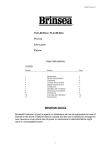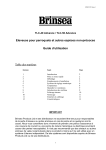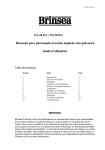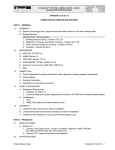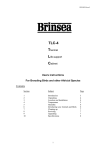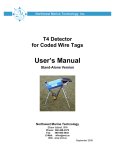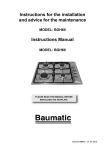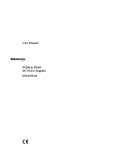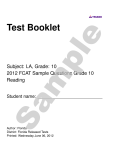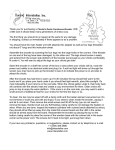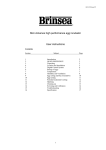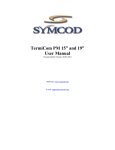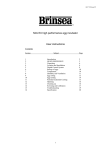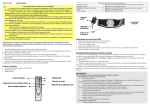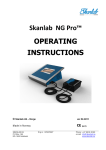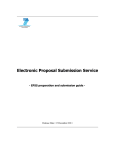Download TLC-40 Advance / TLC-50 Advance User instructions
Transcript
HD401 US Issue 01 ® TLC-40 Advance / TLC-50 Advance Thermal Life-support Cabinet User instructions Contents Section Subject Page 1 2 3 4 5 6 7 8 9 11 12 13 Introduction QUICK REFERENCE Unpacking Location and Assembly Digital Control System Temperature Humidity and Ventilation Introducing Young Birds Internal Lighting Cleaning up Servicing and Calibration Specification 2 2 4 5 6 8 9 9 10 10 11 12 IMPORTANT NOTICE Brinsea® Products Ltd and its agents or distributors will not be responsible for loss of animals in the event of failure however caused and the user is advised to arrange his own insurance cover where loss of power or mechanical or electrical failure might result in unacceptable losses. 1 HD401 US Issue 01 1 Introduction These instructions detail the operation of your new TLC-40 Advance or TLC-50 Advance digital brooder. Please read these instructions carefully before setting up your machine to achieve best results and keep these instructions safe for future reference. Your TLC Advance brooder is designed to allow the user to vary the environmental conditions to suit a wide range of species and the specific set-up for every species is beyond the scope of these instructions. There are a range of books and veterinarian texts available covering animal and avian hand rearing and recovery techniques The TLC Advance brooders are available with the option of the Advance Humidity Pump for automatic humidity control. Operating instructions for this module are supplied separately. Fig. 1 Functional features of the TLC-40 Advance and TLC-50 Advance (40 model shown) Control Buttons Digital Display Outlet for Advance Humidity Pump Temperature Control Housing Power Inlet (at rear) Water Fill Hole Inlet Air Filter (circulation filters are inside) Water Reservoir Pan and Evaporating Block Adjustable Vent Door Latch Door Hinges (Reversible) 2 Quick Reference (please read relevant section for detail) This quick reference is intended to allow users familiar with Brinsea® TLC brooders to quickly set up the brooder and learn the key features of the control system. Please read the rest of the instructions to obtain a full understanding of each feature. DO NOT COVER THE BROODER. FOR INDOOR USE ONLY. 1) Carefully unpack the brooder parts (section 3) 2) Assemble the cabinet (section 4) 3) Fit the power lead 2 HD401 US Issue 01 MAIN MENU – QUICK REFERENCE PRESS BOTH BUTTONS TO UNLOCK THE MAIN MENU SELECT THE OPTION / RETURN TO THE MENU. GO FORWARD ONE SCREEN / INCREASE THE VALUE / DISPLAY IN CELSIUS. GO BACK ONE SCREEN / DECREASE THE VALUE / DISPLAY IN FAHRENHEIT. 30.0C OK - + TEMPERATURE. RANGE 20.0 – 40.0°C (68.0 – 104.0°F). DEFAULT 30.0°C (86.0°F). RH% OK Å Æ RH 20% EX ONLY RELATIVE HUMIDITY. RANGE 20% – 80%. DEFAULT 20%. ONLY FOR EX VERSION WITH ADVANCE HUMIDITY PUMP – SEE SECTION 7. ALARM HI OK Å Æ HI 2.0C OK - + HIGH TEMPERATURE ALARM. RANGE 1.0 – 5.0°C (1.8 – 9.0°F) ABOVE SET BROODER TEMPERATURE. DEFAULT 2.0°C (3.6°F). ALARM LO OK Å Æ LOW 3.0C OK - + LOW TEMPERATURE ALARM. RANGE 1.0 – 5.0°C (1.8 – 9.0°F) BELOW SET BROODER TEMPERATURE. DEFAULT 3.0°C (5.4°F). C/F OK Å Æ DISP C OK C F CELSIUS / FAHRENHEIT DISPLAY. SWITCHES ALL TEMPERATURE FIGURES BETWEEN °C AND °F. DEFAULT °C. TEMP OK Å Æ SAVE OK Å Æ SAVE. ALL CHANGES ARE SAVED. RETURN TO NORMAL OPERATION SCREEN. CANCEL OK Å Æ CANCEL. ALL CHANGES ARE IGNORED. RETURN TO NORMAL OPERATION SCREEN. 3 HD401 US Issue 01 3 Unpacking Your brooder has been supplied in protective packaging. Please remove all tape, strapping and packing from the brooder and parts. Retain the carton and packing materials to enable the unit to be repacked. Your brooder will include as standard: Quantity Item 1 1 1 1 1 1 1 1 1 Brooder top assembly (with 3 air filters fitted) Cabinet base Door Hinge socket Fastener and tool kit Mains cable Water pan Evaporating block Water funnel Fastener and Tool Kit Contents: Quantity TLC-40 Quantity TLC-50 Item 2 2 M5 x 16mm countersunk screws 2 2 M5 flat washers 2 2 M5 domed nuts 12 16 M4 x 30mm cap-headed screws 12 16 M4 star washers 12 16 M4 domed nuts 1 1 1 1 1 1 3mm hex key 4mm hex key 7mm / 8mm wrench 3.1 Please identify each part and check that they are all present and undamaged. If there are any parts damaged or missing please contact your retailer or Brinsea® Products (at the address at the end of the document). 3.2 Note that if your brooder has been ordered with additional options (such as the Advance Humidity Pump) separate instructions and component lists apply. 3.3 Check also that the electrical supply matches the machine’s requirements (marked on the technical label next to the power inlet socket). 3.4 To register your new Brinsea® product please visit www.brinsea.com and follow the link under Customer Service on the top navigation of the home page to qualify for your free 2 year guarantee. If you do not have access to the internet please call 1-888-667-7009. 3.5 Go to www.Brinsea.com and register as a free member of the Brinsea® Email Group to receive the latest news and information such as advance notice about new products, special offers, exclusive competitions and much more. 4 HD401 US Issue 01 4 Location and Assembly 4.1 Your brooder will give best results in a room free from wide temperature variations and with generous ventilation – particularly if several incubators / brooders are running at the same time. Ensure that the room temperature cannot drop on a cold night. Ideally thermostatically control the room at between 68 and 77°F (20 and 25°C). Never allow the room temperature to drop below 59°F (15°C) and ensure that the brooder cannot be exposed to direct sunlight. 4.2 Assemble the cabinet using the tools and fasteners provided. Follow the diagrams. Do not over-tighten fasteners. 4.3 The door is hinged at the left as supplied but may be reversed to provide better access if required. Fit the top hinge socket to the cabinet using the M5 x 16mm countersunk screws, M5 flat washers and M5 dome nuts. 1 4.4 2 3 Place the door in the lower hinge and close the latch. Lower the top cabinet down onto the other parts. 4 4.5 5 6 Fit the M4 x 30mm cap-headed screws, star washers and dome nuts into each set of holes around the edge of the cabinet. Tighten enough to prevent them spinning. This creates an air tight seal around the cabinet. 7 5 HD401 US Issue 01 4.6 Place the white evaporating block upright in the clear water pan. Open the door and lift the pan into position, it pushes up and across into two slots on the heater enclosure. The pad may need to be softened with a little water to help it flatten while the pan is fitted. The pan is located in this manner to help prevent accidental removal by animals. Air Filter 8 9 4.7 Your brooder is supplied with air filter media fitted at the air inlet (see fig 1) and at each end of the heater enclosure (see picture 9 above). For details of filter replacement see the Servicing section. 4.8 Place the brooder on a scratch and moisture resistant surface. Worktop height is ideal. 4.9 Connect the mains cable to the inlet. Ensure the connector is pushed fully home in its socket. 4.10 The fan will start and the display will show the current temperature and humidity in the cabinet plus a "P" symbol to show power was interrupted. 4.11 Allow the brooder to run for at least an hour to stabilise the temperature before making adjustments or introducing animals. 5 Digital Control System T*30.0C H*40% The TLC Advance control system utilises highly accurate, individually calibrated sensors for temperature and humidity. Be cautious of low cost analogue or digital thermometers and hygrometers when comparing them with the brooder display readings. 6 HD401 US Issue 01 5.1 NORMAL OPERATION – Temperature and relative humidity are continuously displayed. The asterisk “*” adjacent to the temperature reading shows when the heater power is on. When warming the asterisk will be continuously on, once warmed up the asterisk will slowly flash as the heater is pulsed to maintain the correct temperature. When reducing the temperature setting the asterisk may go off, this is normal. The asterisk “*” adjacent to the relative humidity display is only on when the pump control output is on (see section 8) and is only applicable when using the optional Brinsea Advance Humidity Management Module. 5.2 POWER LOSS DISPLAY – If power has been interrupted due to a power cut (or when first switching on) a “P” is shown flashing in the corner of the display. Press the - or + button for 2 or more seconds to clear the indicator. If the reason for the power loss is not known check the power cable connections are secure. T*30.0C H 40% P 5.3 HIGH TEMPERATURE ALARM DISPLAY – If the measured temperature goes up by more than the figure in the ALARM HI screen, the alarm will sound immediately and “+T” will be displayed. Press OK to silence the alarm for 30 minutes. If the high temperature problem rectifies itself the “+T” remains on the display to show this has happened. Press OK to clear the indicator. Check the brooder is not (and has not been) in direct sunlight or too near a heat source such as a room heater. T 39.8C H 23% +T 5.4 LOW TEMPERATURE ALARM DISPLAY – If the measured temperature goes down by more than the figure in the ALARM LO screen, after 30 minutes “-T” will be displayed and the alarm will sound. Press OK to silence the alarm for 30 minutes. If the low temperature problem rectifies itself the “-T” remains on the display to show this has happened. Press OK to clear the indicator. Check the brooder is not (and has not been) in a cold draught or that the room temperature has dropped significantly. T*32.1C H 45% -T 5.5 CHANGING SETTINGS – The Main Menu allows the various settings to be modified and saved. All changes are retained in the event of a power cut. To access the Main Menu press the + and – buttons simultaneously to unlock the display. For full details of menu settings please refer to the guide on page 3. 7 HD401 US Issue 01 6 Temperature Stable and correct temperature is essential for good results. Adjust with care. 6.1 Note: your brooder may not be set to the correct temperature from the factory and the following procedure must be followed before introducing animals. 6.2 As the brooder warms up and approaches its control setting the heater on asterisk “*” will change from continuously on to flashing. Allow the brooder to stabilise for at least an hour before adjusting the temperature. 6.3 Press the - and + buttons simultaneously to unlock the main menu. Press OK to select the temperature screen and adjust as necessary using the + and – buttons. Press OK to return to the Main Menu and then scroll down to Save. Press OK to save the changes. When reducing temperature the asterisk may go out while the brooder cools – this is normal. 6.4 Refer to the digital temperature display to check temperature. The display shows the air temperature in increments of 0.1°. 6.5 The Display can be switched to show all temperature settings in degrees Fahrenheit. Press the - and + buttons simultaneously to unlock the main menu. Scroll to the C/F option and press OK to select the C/F display screen. Press the + button to select °F or the – button to select °C. Press OK to return to the Main Menu and then scroll down to Save. Press OK to save the changes. 6.6 TEMPERATURE GUIDELINES FOR BROODING HATCHLING CHICKS. As a general rule a newly hatched chick will need a brooder temperature a little lower than incubation temperature, about 95-97°F (35-36°C) and the temperature can be reduced progressively at about 1°F (0.5°C) per day until it is fully feathered or no longer requires supplementary heat. In warm ambient conditions this will be sooner than in cold climates. When brooding temperatures are just above room temperature the asterisk heater indicator may go out (indicating that no heat is being applied). This indicates that the birds are ready to be moved to a nursery cage. If room temperature then drops (e.g. at night) then the birds can be kept warm by replacing them into the TLC brooder. 6.7 Where there is to be a continuous throughput of birds of differing stages of development, several TLC brooders can be set to different temperatures and the birds moved to cooler units as they grow. 6.8 The Recommended staged temperature settings for most parrots and falcons: Days 1 to 5 Days 6 to 10 Days 11 to 15 Days 16 to 25 97°F (36°C) 91°F (33°C) 85°F (29.5°C) 80°F (27°C) These temperatures have been found to promote optimal health and growth from newly hatched chicks and are a little higher than may be found in nests. Where birds are taken from a nest after more than a few days, the temperature setting will usually need to be a few degrees lower to prevent heat stress. The recommendations above are for guidance only, always observe the chick’s behaviour (see below) to verify setting. Temperatures too high can cause heat stress, dehydration, deformities or haemorrhaging under the skin. Low temperature may reduce appetite and retard growth. Observation of the bird is the best guide to its comfort. Chicks try to huddle together if cold and move about seeking parental warmth. Chicks too warm separate and pant. In either case they will complain vocally. Comfortable birds will lie quietly sleeping with wings loosely folded at the sides, usually in contact with one another. 6.9 The TLC-40 Advance and TLC-50 Advance have a built-in temperature alarm which warns of high or low temperatures. See section 5 for details. 6.10 Developing chicks are fairly tolerant of short-term temperature drops but care should be taken about cooling that occurs during feeding or inspection. Keep the room warm, hold the bird in a cloth to prevent chilling from cold hands and use warmed feeding utensils. 8 HD401 US Issue 01 7 Humidity and Ventilation Elevated air temperatures in the TLC brooder will reduce the relative humidity level(RH) and can cause dehydration. A water reservoir is fitted to counteract this effect. 7.1 Your TLC brooder is fitted with a water reservoir (see fig.1) which humidifies air as it is drawn into the heater enclosure. Use a solution of Brinsea® Incubation Disinfectant (1part concentrate to 100 parts water) in the water reservoir (pan) to inhibit bacterial build-up. It is recommended that the reservoir is topped up with solution daily to reduce dehydration. This can be a particular problem with chick(s). Relative humidity of between 45 and 55% RH is adequate for brooding. Avoid very high levels as condensation may form on cooler surfaces. 7.2 The brooder and its occupants need not be disturbed to fill the water pan. Use the funnel provided to pour water through the water fill point in the top of the brooder (see fig. 1) directly onto the evaporating block and into the water pan. Push the funnel down gently into the hole to make sure the water pours directly in. Clean up any spilled water from the top of the brooder immediately. 7.3 To further increase humidity levels within the brooder the water reservoir is fitted with an evaporating block of absorbent paper mesh as standard. This block may be set across the water pan (instead of upright) or removed entirely to give lower humidity levels. The block can provide a breeding ground for bacteria. In addition to the use of Brinsea® Incubation Disinfectant concentrate in the water, it is recommended that the block is replaced every 2 months of use. 7.4 An adjustable vent is fitted to the door of the brooder which may be opened or closed to give greater control of humidity (close vent to increase) and fresh air flow. The vent may be fully closed as fixed ventilation is also provided. 7.5 The Brinsea® Advance Humidity Pump is available as an option for the TLC Advance brooder. The brooder digital control system not only reads the humidity in the brooder but it provides a control signal to operate the water pump and accurately maintain the humidity level at the desired level. 8 Introducing Young Birds Once the correct temperature has been established and the air humidified the TLC brooder is ready for use. 8.1 For newly hatched chicks use small plastic tubs such as ice-cream or butter / spread containers lined with paper towel. Young birds of similar age and size can be placed together and benefit from the warmth and comfort. If disparity in size is too great the smaller animal is at risk of being crushed or smothered. 8.2 For larger chicks and adult birds line the base of the TLC brooder with paper towelling and place the bird(s) directly on this. The brooder cabinet material is smooth and designed to be easy to clean. 8.3 Change paper towel at each feed or at least four times a day. 8.4 Follow feeding regimes recommended for your species ensuring the highest standards of hygiene at all times. 8.5 In order to maintain maximum air-flow the air-flow filters should be checked once a week for dust or down, and cleaned if necessary. 9 HD401 US Issue 01 9 Internal Lighting 9.1 The TLC Advance brooders are equipped with gentle, internal LED lighting for night-time inspection of animals and birds. The LED lamps are energy efficient, do not affect temperature and would not normally require replacement. Amber colour LED's do not produce UV light often associated with "white" LED's. 9.2 The LED lights are located to the left of the fan diffuser in the TLC-40 size model and on both sides of the fan diffuser on the larger TLC-50 model. 9.3 The lights may be switched on and off by pressing the OK button. This has a toggle action. LED lamp location (TLC-50 only) LED lamp location (TLC-40 and TLC-50) 10 Cleaning Up IMPORTANT: DISCONNECT THE BROODER FROM THE MAINS POWER SUPPLY DURING CLEANING. RISK OF ELECTRIC SHOCK! ENSURE THAT ALL ELECTRICAL PARTS ARE KEPT DRY. 10.1 Following each brood in your TLC brooder remove all debris from the floor. Wipe all internal surfaces with a soft cloth soaked in 100:1 Brinsea® Incubation Disinfectant solution. Filters should be inspected on a weekly basis and be cleaned if necessary. Remove all three filters and gently hand wash in warm water then allow them to dry before use. Filters need replacing every six months. Immerse and soak any nest tubs in disinfectant solution. The exterior of the TLC brooders may be cleaned with a damp cloth. USE WATER BASED DISINFECTANTS ONLY WHEN CLEANING 10.2 Always clean the TLC brooder before storage and ensure that the unit is totally dry inside and out or damage may occur to the components. 10.3 For deeper cleaning the base of the cabinet and the door may be removed by releasing the fasteners. See section 4 for assembly guide. The cabinet base and the door may be wet-cleaned with mild detergent and then disinfected with water based disinfectant solution such as Brinsea® Incubation Disinfectant. Replacement filters, evaporating blocks and disinfectant solution are all available from Brinsea® Products at the address at the end of this document or from your Brinsea® agent. 10 HD401 US Issue 01 11 Servicing and Calibration 11.1 Although it is not regarded as necessary for routine cleaning, the heater enclosure may be safely removed to allow the heater and fan to be dusted. Disconnect the power lead. Remove the water pan. Loosen the 4 cap-head screws (on top of the white plastic cabinet, not the grey control box) as shown and then finally remove each one while supporting the metal enclosure inside. The metal enclosure will fall if not held and may damage the brooder. 11.2 Carefully place the brooder on its top and then lift out the metal heater enclosure. The fan assembly may then be hinged over toward the front of the machine so that the heating element and fan blades may be dusted with a soft brush. USE NO LIQUIDS. DO NOT DISTURB THE TEMPERATURE SENSOR. DO NOT DISTURB SENSOR Fan assembly may be hinged out on its cables to allow fan and heater to be dusted with a soft brush Fan assembly is located by 4 pegs in the feet of the clear moulding 11.3 Once the heater area has been dusted the fan assembly must be relocated by ensuring the 4 pegs on the clear moulding fit into the corresponding holes in the metal base plate. 11.4 ENSURE THE FAN / LED WIRES ARE NOT TOUCHING THE HEATING ELEMENT 11.5 Replace the metal cover so that the water pan slots are at the correct end. Hold the cover in place and fit the 4 cap-head screws. Do not over-tighten. 11 HD401 US Issue 01 11.6 In case of failure first check that the mains power supply is working and that the mains cable connector is fully engaged in the socket at the rear of the control housing. Check the fuse in the mains inlet on the rear of the control housing. Replace with a fuse of the same type and rating if necessary. 11.7 The digital control system may be reset to the original factory defaults by connecting the power supply while holding the OK button. If the problem persists contact your distributor or Brinsea® Products Service Dept. 11.8 The digital temperature and humidity display is individually calibrated during manufacture but may be recalibrated if required. To ensure optimal performance return the brooder to Brinsea® Products Service dept. for re-calibration every two years. It is not recommended that this procedure is carried out by the user. BE CAUTIOUS OF LOW COST ANALOGUE OR DIGITAL THERMOMETERS AND HYGROMETERS. BRINSEA PRODUCTS LTD USES SOPHISTICATED INTERNATIONAL REFERENCE STANDARDS. EQUIPMENT TRACEABLE TO To access the Calibration Menu press all three buttons simultaneously to unlock the display. See page 14 for details of the Calibration Menu. 12 Specification TLC-40 Advance TLC-50 Advance Overall height Overall width Overall depth Floor area Effective volume Weight 18.5" (470mm) 19" (485mm) 15" (385mm) 15.5 x 12" (400x300mm) 10USgal (40L) 15lbs (6.7Kg) 21.5" (550mm) 27" (690mm) 19.5" (490mm) 23.5 x 15.5" (600x400mm 26USgal (100L) 19lbs (8.7Kg) Power consumption 85W typical, 150W max 100W typical, 150W max Power supply 115V 60Hz or 230V 50Hz as ordered Brinsea Products Inc., 704 N Dixie Ave., Titusville, FL 32796-2017 USA. Phone. (321) 267-7009 Toll Free 1-888-667-7009 Fax (321) 267-6090 e-mail [email protected], website www.Brinsea.com 12 HD401 US Issue 01 CALIBRATION MENU PRESS ALL 3 BUTTONS TO UNLOCK THE CALIBRATION MENU SELECT THE OPTION / RETURN TO THE MENU. GO FORWARD ONE SCREEN / INCREASE THE VALUE. GO BACK ONE SCREEN / DECREASE THE VALUE. CAL TEMP OK Å Æ T 30.0C OK CAL! CALIBRATE THERMOMETER. TAKE READINGS AT SEVERAL PLACES 1.5" (40mm) ABOVE THE BASE OF THE EMPTY BROODER AND CALCULATE THE AVERAGE. CAL RH% OK Å Æ RH 28% OK CAL! CALIBRATE HYGROMETER. PLACE HYGROMETER IN BASE OF BROODER WITH NO WATER IN THE RESERVOIR PAN. RH CYCLE OK Å Æ RHC 16s OK - + HUMIDITY PUMP CYCLE TIME. ONLY APPLICABLE WHEN USED WITH THE BRINSEA ADVANCE HUMIDITY PUMP. AMBIENT OK Å Æ T 20.0C OK - + BGHEAT OK Å Æ BGH60% OK - + SAVE OK Å Æ CANCEL OK Å Æ 13 AMBIENT TEMPERATURE COMPENSATION. AMBIENT TEMPERATURE USED IN HEATER CONTROL ALGORITHM. ONLY ADJUST IF TYPICAL ROOM TEMPERATURE IS GREATER THAN 9°F (4°C) DIFFERENT. BACKGROUND HEATING LEVEL. HEATER POWER ADJUSTMENT USED IN HEATER CONTROL ALGORITHM. ONLY ADJUST WITH ADVICE FROM BRINSEA PRODUCTS.













